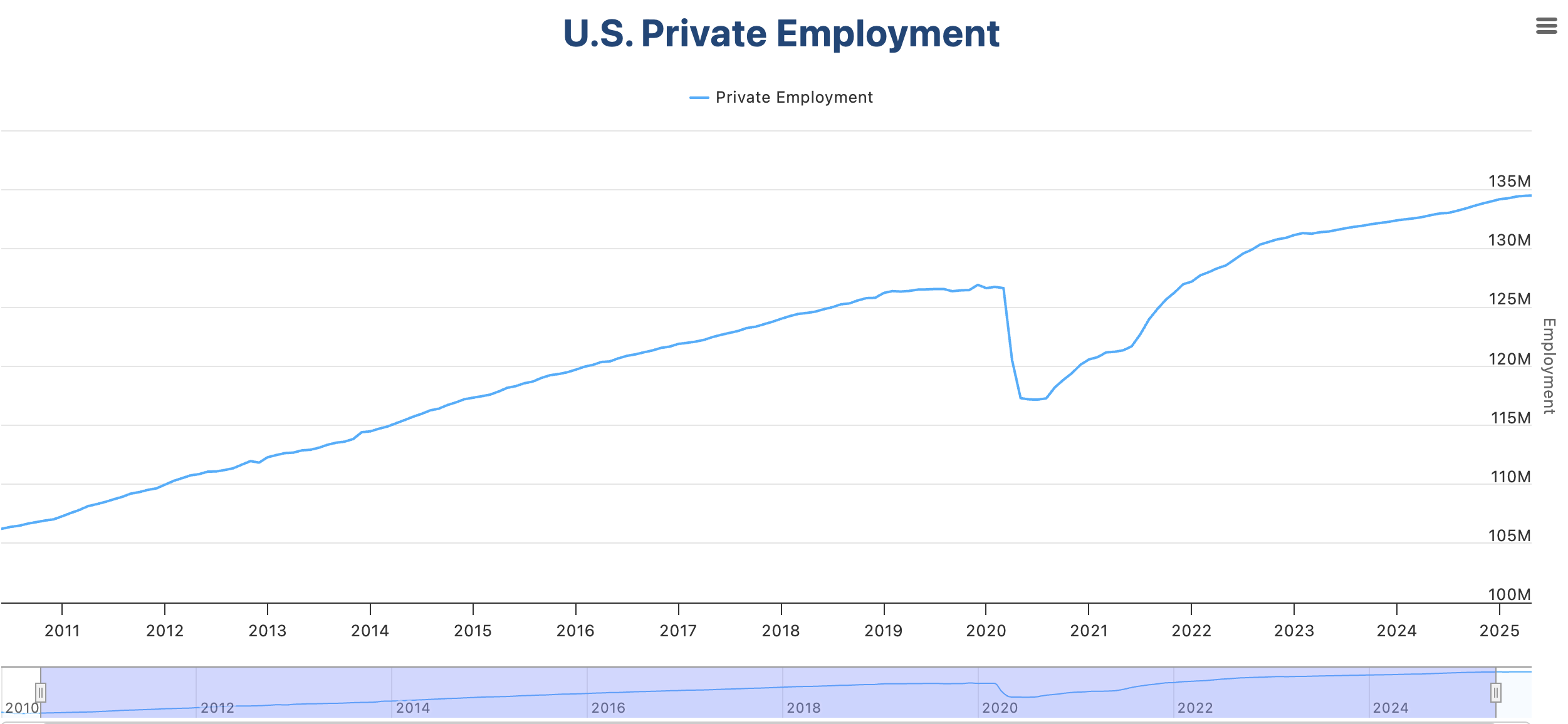
Private sector employment in the US rose by 42,000 in October and annual pay was up 4.5%, Automatic Data Processing (ADP) reported on Wednesday. This reading followed the 29,000 decrease (revised from -32,000) recorded in September and came in better than the market expectation of 25,000.
Commenting on the report's findings, Nela Richardson, chief economist at ADP, stated, "Private employers added jobs in October for the first time since July, but hiring was modest relative to what we reported earlier this year." “Meanwhile, pay growth has been largely flat for more than a year, indicating that shifts in supply and demand are balanced,” she added
Market reaction to ADP Employment Change data
This report failed to trigger a noticeable market reaction. At the time of press, the US Dollar (USD) Index was virtually unchanged on the day at 100.20.
US Dollar Price This week
The table below shows the percentage change of US Dollar (USD) against listed major currencies this week. US Dollar was the strongest against the New Zealand Dollar.
| USD | EUR | GBP | JPY | CAD | AUD | NZD | CHF | |
|---|---|---|---|---|---|---|---|---|
| USD | 0.39% | 0.76% | -0.15% | 0.85% | 1.01% | 1.49% | 0.73% | |
| EUR | -0.39% | 0.37% | -0.46% | 0.46% | 0.61% | 1.10% | 0.34% | |
| GBP | -0.76% | -0.37% | -0.98% | 0.09% | 0.24% | 0.72% | -0.03% | |
| JPY | 0.15% | 0.46% | 0.98% | 0.96% | 1.13% | 1.61% | 1.00% | |
| CAD | -0.85% | -0.46% | -0.09% | -0.96% | 0.09% | 0.61% | -0.11% | |
| AUD | -1.01% | -0.61% | -0.24% | -1.13% | -0.09% | 0.49% | -0.26% | |
| NZD | -1.49% | -1.10% | -0.72% | -1.61% | -0.61% | -0.49% | -0.74% | |
| CHF | -0.73% | -0.34% | 0.03% | -1.00% | 0.11% | 0.26% | 0.74% |
The heat map shows percentage changes of major currencies against each other. The base currency is picked from the left column, while the quote currency is picked from the top row. For example, if you pick the US Dollar from the left column and move along the horizontal line to the Japanese Yen, the percentage change displayed in the box will represent USD (base)/JPY (quote).
This section below was published as a preview of the ADP Employment Change at 07:00 GMT.
- The ADP Employment Change report is expected to show a modest improvement in private sector payrolls in October.
- The ADP report will gain relevance in the absence of other labor market data releases.
- The US Dollar is trading firm following the Fed’s hawkish pivot last week.
The Automatic Data Processing (ADP) Research Institute will release its monthly report on private-sector job creation for October on Wednesday. The so-called ADP Employment Change report is expected to show that the United States (US) economy created 25,000 new positions, following a 32,000 net decline in September.
These figures will attract particular interest this month, as the US Government shutdown extends for the fifth week already, and is highly likely to deprive the market and the Federal Reserve (Fed) of the closely watched JOLTS Job Openings and the key Nonfarm Payrolls (NFP) report this week.
ADP Jobs Report: Employment and the Federal Reserve
The mounting evidence of the US labour market’s deterioration has been a key factor in prompting the Federal Reserve to cut rates by 25 basis points on October 29, and remains a major concern for the dovish members of the Monetary Policy Committee (MPC), which keeps pushing for a more supportive policy.
Against this background, October’s ADP report seems unlikely to give reasons to celebrate. Private sector payrolls are expected to have bounced up, almost fully reverting September’s decline, but still showing numbers consistent with a weak labour market.

Preliminary estimates released by ADP last week revealed that net employment showed an average growth of 14,250 jobs in the four weeks ending on October 11, and the market consensus anticipates 25,000 new jobs in October. These figures would partially offset the 32,000 decline witnessed in September, yet they stand at levels well below the 150,000 average new jobs created per month over the last 15 years.
From the monetary policy perspective, the ADP is highly likely to confirm the challenging situation ahead for the Fed, which will have to fine-tune its monetary policy between a weak labor market and higher inflationary risks. This situation has created a wide divergence among policymakers, which was pointed out by Fed Chairman Jerome Powell as the main reason for cooling hopes of further monetary easing in December.
As it stands, chances of a 25 basis points rate cut in December have declined to 64% from above 90% last week. This has been one of the main drivers for the recent US Dollar (USD) recovery. In this case, a strong ADP reading might ease fears about employment and shift the focus back to inflation, endorsing Powell’s hawkish view and providing an additional impulse to the US Dollar.
Another disappointment, on the other hand, and especially if there is a further decline in net jobs, would likely boost pressure on the central bank to keep lowering borrowing costs and, in turn, send the US Dollar lower.
When will the ADP Report be released, and how could it affect the USD Index?
ADP will release the US Employment Change report on Wednesday at 13:15 GMT, and it is expected to show that the private sector added 25,000 new positions in October.
Heading into the release, the US Dollar appreciated against its main peers after the “hawkish cut” delivered by the Federal Reserve last week. The US Dollar Index (DXY) has rallied nearly 1.3% since then, reaching the 100.00 psychological level.

From a technical perspective, Guillermo Alcala, Analyst at FXStreet, highlights the resistance area above the 100.00 pshycholkigical level: “The US Dollar Index is on a bullish cycle amid dwindling hopes of Fed interest rate cuts but the Relative Strength Index (RSI) is approaching overbought levels in most timeframes as price action nears an important resistance level between 100.00 and August’s peak, at 100.25. A bearish correction from these levels should be considered.”
Downside attempts, however, are likely to remain limited, says Alcala: “A potential pullback from current levels is likely to find support at the October 9 high near 99.55 or the October 30 low, at the 98.90 area. To the upside, above 100.25, the targets are the May 29 high near 100.55, and the May 16 high, at 101.25.”
US Dollar FAQs
The US Dollar (USD) is the official currency of the United States of America, and the ‘de facto’ currency of a significant number of other countries where it is found in circulation alongside local notes. It is the most heavily traded currency in the world, accounting for over 88% of all global foreign exchange turnover, or an average of $6.6 trillion in transactions per day, according to data from 2022. Following the second world war, the USD took over from the British Pound as the world’s reserve currency. For most of its history, the US Dollar was backed by Gold, until the Bretton Woods Agreement in 1971 when the Gold Standard went away.
The most important single factor impacting on the value of the US Dollar is monetary policy, which is shaped by the Federal Reserve (Fed). The Fed has two mandates: to achieve price stability (control inflation) and foster full employment. Its primary tool to achieve these two goals is by adjusting interest rates. When prices are rising too quickly and inflation is above the Fed’s 2% target, the Fed will raise rates, which helps the USD value. When inflation falls below 2% or the Unemployment Rate is too high, the Fed may lower interest rates, which weighs on the Greenback.
In extreme situations, the Federal Reserve can also print more Dollars and enact quantitative easing (QE). QE is the process by which the Fed substantially increases the flow of credit in a stuck financial system. It is a non-standard policy measure used when credit has dried up because banks will not lend to each other (out of the fear of counterparty default). It is a last resort when simply lowering interest rates is unlikely to achieve the necessary result. It was the Fed’s weapon of choice to combat the credit crunch that occurred during the Great Financial Crisis in 2008. It involves the Fed printing more Dollars and using them to buy US government bonds predominantly from financial institutions. QE usually leads to a weaker US Dollar.
Quantitative tightening (QT) is the reverse process whereby the Federal Reserve stops buying bonds from financial institutions and does not reinvest the principal from the bonds it holds maturing in new purchases. It is usually positive for the US Dollar.








